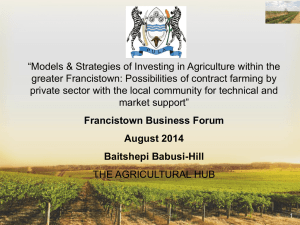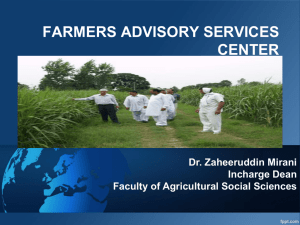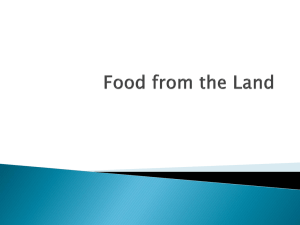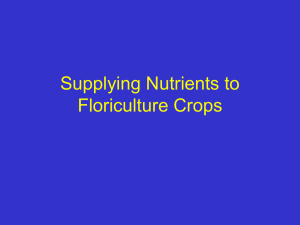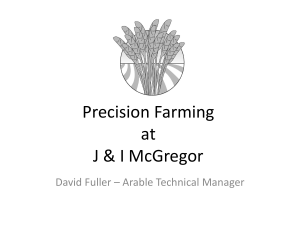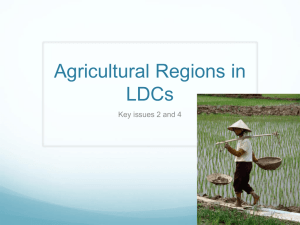ppt notes
advertisement
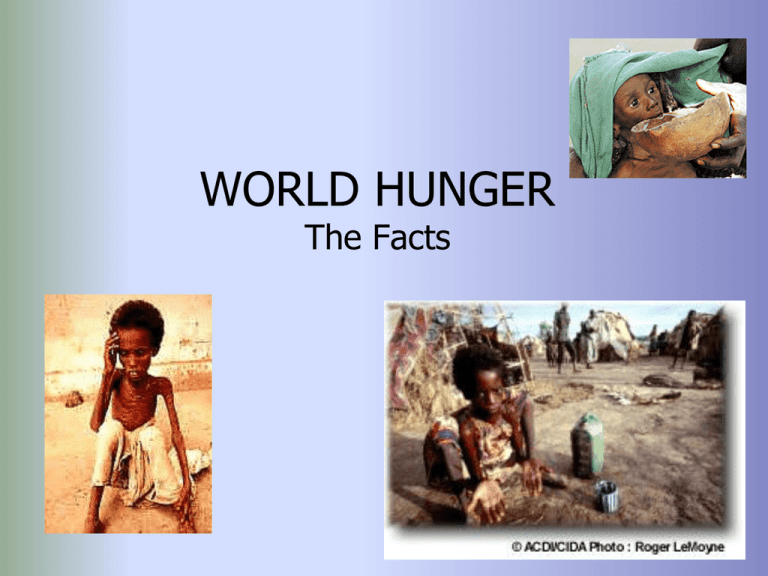
WORLD HUNGER The Facts WORLD HUNGER FACTS • More than 840 million people in the world are malnourished—799 million of them are from the developing world. More than 153 million of them are under the age of 5. • 6 million children under the age of 5 die every year as a result of hunger. • Of the 6.2 billion people in today's world, 1.2 billion live on less than $1 per day. • The proportion of people living on less than $1 a day has fallen from 29 percent to 23 percent in the past 10 years, although that masks significant regional differences. – East Asia has seen a drop from 28 percent to 14 percent. – South Asia has seen a drop from 44 percent to 37 percent. – Africa has seen a drop from 48 percent to only 47 percent. World Hunger Facts • The amount of money that the richest 1 percent of the world's people make each year equals what the poorest 57 percent make. • The richest 5 percent of the world's people have incomes 114 times that of the poorest 5 percent. • Malnutrition can severely affect a child's intellectual development. Children who have stunted growth due to malnutrition score significantly lower on math and language achievement tests than do well-nourished children. • Virtually every country in the world has the potential of growing sufficient food on a sustainable basis. The Food and Agriculture Organization of the United Nations has set the minimum requirement for caloric intake per person per day at 2,350. Worldwide, there are 2,805 calories available per person per day. Fifty-four countries fall below that requirement; they do not produce enough food to feed their populations, nor can they afford to import the necessary commodities to make up the gap. Most of these countries are in sub-Saharan Africa. World Hunger • • • • • Vocabulary Why Food: The Basics Agricultural Development Food Production: Factors Reasons for Food Crisis World Hunger: Terms FAMINE • A temporary failure of food production or distribution systems in a particular region that leads to increased mortality due to starvation and diseases that result from lack of food. – Natural Causes: drought, crop disease – Human Causes: civil war Example: 1984 Famine in Ethiopia “Up to five children die every day” Read more about the Ethiopian Famine Is it going to happen again? World Hunger: Terms Starvation • An extreme form of hunger in which people suffer from a total lack of energy and essential minerals. The body wastes away as tissue is consumed to provide protein and energy. Malnutrition • a condition which damage to health is caused by a diet that includes either too much or too little of one or more essential nutrients over an extended period. - This could include obesity and high blood pressure as these are caused by excesses in diet - International development usually focuses on lack of nutrients or poor food quality. This type of malnutrition is called undernutrition. The Importance of Food • Provides materials and nutrients for cell growth. It provides us with the energy we need for growth, physical activity and the basic body functions (breathing, thinking, temperature control, blood circulation and digestion, metabolism). Food also supplies us with the materials to build and maintain the body and to promote resistance to disease. • Food gives the body energy – Kilojoules (KJ) or Calories (Note: if all of the Calories that we eat are not burned up for energy use the body stores these calories as Fat). – An average person needs about 2200 kcal per day. 1800 min to survive? – A Canadian gets on average 2900 KJ per day. – What pattern do you see on the following map? Food and Agriculture Organization - The UN Food: Nutrients • These different functions are made possible by the nutrients contained in food. The types of nutrients in food are carbohydrates, proteins, fats, vitamins, minerals and water. All foods contain one or more of these nutrients in varying amounts. Each type of nutrient serves particular functions. This is why diversity in our diets is important for good health. We need all of the nutrients, provided by a variety of foods, for all of our body processes. • Although one may eat enough kilo-calories of food, one can still suffer from malnutrition, if there is a lack of essential nutrients. • This can result in a variety of diseases. One of the most common being PEM (protein-energy malnutrition) Food: Nutrients CARBOHYDRATES Chemical group including – sugar, starch, carbon and oxygen. Wheat, rice, corn, potatoes Easy to produce. Grains are the most important in the world. Food: Nutrients FATS Tissue of animals 37.8 KJ of energy for every 1 gram of fat. Most concentrated form of food energy. Butter, lard, liver, eggs, vegetable oil, fruit. Food: Nutrients PROTEIN Amino acids Protein is needed to grow and repair tissue. Meat, milk, egg, fish, cereals and Soya beans. Protein is the most expensive and scarce of the three. Agricultural Development – First Agricultural Revolution – creation of farming – Second Agricultural Revolution – energy, tractors, diffusion of crop types – the development of the plough (plow) over time (spatial diffusion lead to widespread increase in cultivation – some places just starting to use it). (started BCE into 900 CE) – More effective use of land – intensive vs. extensive cropping systems. – The introduction of steam powered tractors, diffusion of crop types, fertilizers, specialization (1600-1870s) – Green Revolution or Third Agriculture Revolution – development of High Yield Varieties (wheat) (1945 – 1970). – Second Green Revolution? – biotechnology, GMOs, agribusiness, corporations, globalization. (1990- present date) Food Production The Factors Required Food is the basic resource of the world’s population. The production of food depends on the following factors: • Environmental – climate, soils • Technological – irrigation, fertilizer, pesticides (insects), herbicides (weeds) and storage of food • Economical/Political – pricing, trade, export/import, tariffs, subsidies, distribution, taxes etc. • The key factor, of course, is environmental. Food Production The Factors Required: Environmental Climate • Solar energy or heat requirement. – This is measured by the length of the ‘Growing Season’ (the number consecutive days where no frost occurs and the temperature is over 5.50 C.) or the number of ‘Degree Days’ (summing the number of degrees each day’s average temperature is over 5.50 C.) • Moisture requirement. – This is measured in the amount of Precipitation. – Evapotranspiration. This is the movement of water from the soil into the atmosphere by evaporation from the soil and transpiration from plants. Food Production The Factors Required: Environmental Soil Fertility • Soil is a complex substance that includes minerals, living and decaying organic materials, water and air. • The amount of decaying organic material (Humus) is most important – determines the soil’s fertility. • Technologies such as irrigation and fertilizers add to the health of a soil. • Poor agricultural practices such as excessive cultivation of the land leads to unproductive soil. Food Production The Factors Required: Environmental Topography • Flat land is best for uniform crop growth. Biological Organisms • Organisms are highly beneficial for farming. Earthworms are needed for soil aeration and bees of course for pollination. Unfortunately other organisms like insects can be destructive as well as plants like weeds. Food Production The Factors Required: Environmental Few places in the world are ‘perfect’ for farming • long enough growing season, • not too much and not too little moisture, • rich soils, level land, and just the right mix of biological conditions. • Most of the time there is some ‘deficiency in one or more of the above factors and farmers must work at overcoming them. • The chart in the next slide illustrates some of the deficiencies and the adjustments that farmers need to make. Food Crisis Population size and growth Some countries are having trouble matching food production to their population growth (reasons for this are given in the next few slides). Malthus of course predicted this, although the massive starvation and death did not happen on a global scale due to the following reasons: a) New areas of agriculture were opened up – prairies in N.A., Australia and South Africa – mainly due to irrigation. b) Science and technology - Green revolution and GMO’s (Genetically Modified Organisms). Some crops grew faster, yielded more and were disease resistant. c) Better transportation and storage. Reduced waste and allowed movement from deficit areas to surplus areas, especially for emergency food aid. Reasons For Food Crisis 1. Low level of agricultural technology Agricultural activities can be classified in TWO ways. The first (A) can classify farming as either Subsistence or Cash-Cropping: A1. Subsistence Farming – Farmers that grow crops and raise livestock for their own use. Grow enough to keep them and their families alive. A2. Cash-Crop Farming – Farmers that grow a surplus and sell on the open or world market. Farm for a living. Reasons For Food Crisis 1. Low level of agricultural technology The second way (B) classifies farming as either Intensive or Extensive farming: B1. Intensive Farming: involves farming on small amounts of land. The farming is concentrated and labour intensive as well as technology. Growing fruits and vegetables, vineyards, and livestock in Canada in an example. B2. Extensive Farming: involves large amounts of land with limited amounts of labour. Machines do most of the work. Grain farming in Western Canada is a good example. Ranching is also considered extensive farming Reasons For Food Crisis 1. Low level of agricultural technology Some countries in the developing world are still using traditional farming methods. Some (Northern Africa) even use the old Hunting and Gathering technique. This method is primitive, time consuming, unreliable, there is no storage involved and it is greatly susceptible to climate. Some countries use a method called Shifting Cultivation or Slash and Burn. In this method an area will be farmed for a year, then after Harvest the crop will be burned to add nutrients and farmed again the next year. After a few years the soil’s fertility will be weak, so the farmer moves into a new area. Burning is again used to clear the new area. An example would be in the Rainforest in South America. Reasons For Food Crisis 1. Low level of agricultural technology The developed world uses methods that produce a very high yield for the area farmed. The methods have been called; Settled agriculture, Permanent agriculture, Commercial agriculture, Agribusiness and Mixed Farming. All of these involve a market economy where the price is dependent on supply and demand. The farming is usually specialized in a few crops, if not one. Fertilizer, irrigation and herbicides are used extensively. The farming is heavy mechanized (tractors etc.). It is not family oriented, it is run like a business. These farms are large in size and are very productive. Reasons For Food Crisis 1. Low level of agricultural technology Agribusiness is a unique term and relates to ‘Vertical Integration’, which means that a company like Kraft Foods will own all aspects of making a product like cheese. They will own the diary farm, the farm that grows the food for the cows, the processing and packaging plants as well are owned by Kraft. • 1.5 billion hectares or 11% of the earth’s total surface is devoted to crops. • 3.4 billion hectares or 26% to pasture land. • most ‘non-agricultural’ land is too hot, dry or cold. This land is sometimes called ‘Marginal land’. Reasons For Food Crisis 1. Low level of agricultural technology Aquaculture and Hydroponics are two other buzz words used by developed farmers. Aquaculture is the harvesting of fish in control environments. Fish are usually grown in large tanks. The worry of disease and predators is eliminated. Hydroponics is the growing of crops without the use of soil. The medium used is water. Most of this type of farming is done in greenhouses and this removes the expense of land, weed control and pests. Fertilizer costs are also kept at a minimum and of course water shortage is not an issue. Reasons For Food Crisis 2. Pests and Fertilizer use • Pests (especially rats) eat 10-25% of the world’s entire food grain output. Some say “solve the pest problem and you will have solved the food problem”. Even the pests droppings are a problem. • Fertilizer use can lead to something called ‘diminishing returns’. You have to add just the right amount of fertilizer for optimal yields. If you add more the yield diminishes. Reasons For Food Crisis 2. Pests and Fertilizer use Fertilizer (kg) 1 2 3 4 5 6 Total Yield (bushels) Increase (bushels) 10 21 32 42 51 59 10 11 11 10 9 8 In this case the point of diminishing returns is at 4 pounds of fertilizer. Reasons For Food Crisis 2. Pests and Fertilizer use In the US 59 kg (130 pounds) of fertilizer for every acre of cropland. The same fertilizer, which in the US gives only marginal returns, would dramatically boost output in countries or regions where fertilizer use is low. Improvements are being made with fertilizer use, especially with GPS and GIS to allow farmers to target the use. Reasons For Food Crisis 3. Economy – Controlling Prices The developed world (the Haves) control the economy and trade and will not allow the developing world (the Have – nots) to compete. Tariffs: Tax placed on imported goods to allow the domestic goods to compete Example: The Ivory Coast is a major producer of Cocoa. Canada allows the Cocoa in duty-free, since we can’t grow it. But we will tax chocolate made in the Ivory Coast to protect our chocolate industry. The Ivory Coast is not allowed to industrialize and remains an agricultural supplier of Cocoa. Reasons For Food Crisis 3. Economy – Controlling Prices Subsidize: Governments in developed countries give money (subsidies) to their farmers to keep the prices of certain agricultural products down so they can be more competitive in the world market. Aid: The developed countries will aid the developing countries in food supplies, but the aid is sometimes connected to some other kind of favour. The US gives a country food, but then expects to be able to place a military base in that country. This type of aid as we will see in another unit is called ‘Boomerang aid’. Reasons For Food Crisis 4. Military Spending: Countries would rather spend money of machines of death. Countries like North Korea, Iraq and others spend billions on military equipment while their populations go hungry. Reasons For Food Crisis 5. Land Holdings: If a farmer owns his/her own land they will take better care of it. The U.S.S.R. had a system (Collective farming) where the government owned the land and the farmers worked there much like a factory. This system was a disaster since the farmer had no incentive to improve the land. Absentee Landlords: In many countries the rich own the land and they either leave the land alone or they rent it out to ‘peasant farmers’. Reasons For Food Crisis 5. Land Holdings: Gavelkind Laws: As a farmer’s family increases each successive generation gets a piece of land. The land is divided into smaller units that are not as productive. Eg. A farmer has four children, his farm is divided into four. One child decides to leave his land and not farm. The others are left with 1/3 of the original farm. 6. Lack of an Infrastructure: The developing world lacks electricity, roads, trucks, railways, storage facilities and distribution networks. Even if they did grow food it would be difficult for them to distribute it. Reasons For Food Crisis 7. The Physical Environment: 20% too dry 20% too mountainous 20% too cold 10% the soil is poor 21% potentially arable – something has to be done to the land Only 9% of the earth is cultivated. One fear worth mentioning at this time is the expansion of cities. Cities tend to locate near cultivated land. Once the city starts to grow, valuable farmland is lost. The area surrounding Toronto is a perfect example. Reasons For Food Crisis 8. Political Organizations: Communist Countries: set the price for food – there is no incentive for the farmer to improve his/her output. Many times the farmer sells only to the government (at a low price) and the government sells to the people. Capitalist Countries: Price is dependent on Supply and Demand. Rich countries can manipulate supply and demand and in turn control the price. Reasons For Food Crisis 8. Political Organizations: If Supply goes up (increase in surplus food) and the demand stays constant, the price of the food should drop. The rich country’s farmers can afford to: a. Store the surplus food b. destroy the surplus or c. the government will pay them NOT to grow any more. The above method lowers the supply thus increasing the price allowing the farmer to control the price and get more money for his crops. This allows the rich farmer to better compete on the world market. The poor country’s farmers have not control and thus have difficulty competing. Reasons For Food Crisis 8. Political Organizations: The rich farmers can even increase demand through advertisement. Today it is in style to advertise healthy, low fat food. In a capitalist system the rich farmer can get loans and credit and the poor farmer has difficulty staying in business. Co-operatives have been created to make the small farmer more competitive. A Co-op is when many farmers get together and buy seed and equipment as one. The cost is lowered. This is also called ‘Economies of Scale’. Buy in bulk so to speak. Reasons For Food Crisis 9. Surplus in Developed Countries: When a surplus is grown in the developed world, much of it is stored or destroyed in order to keep the prices up. This extra food could be given as aid to starving people. 10. Animals and Pets: Since meat is a major part of the developed world’s diet. A lot of food is given to animals to beef them up so to speak. Cattle and Pigs are the main recipients. A lot of food is also used for the making of pet food. THE END

